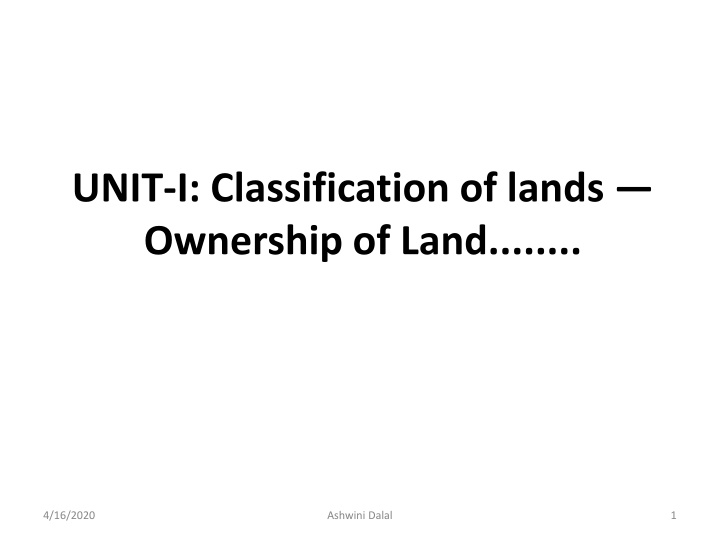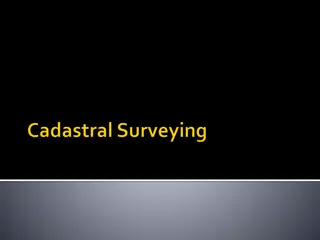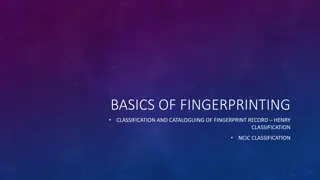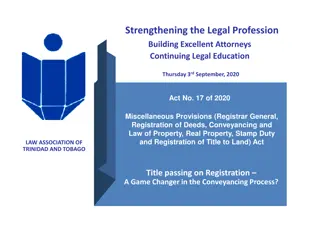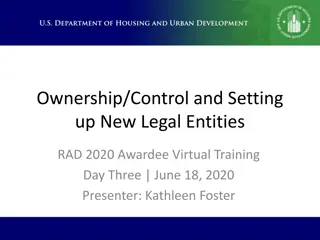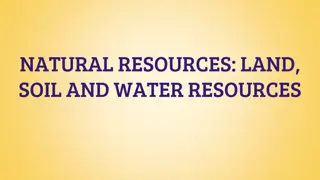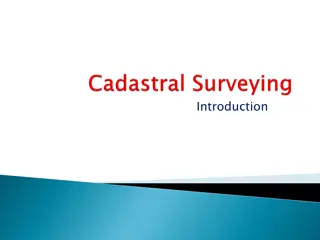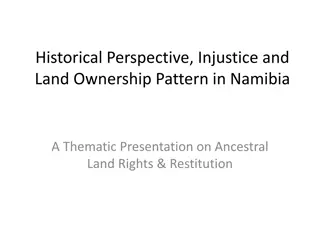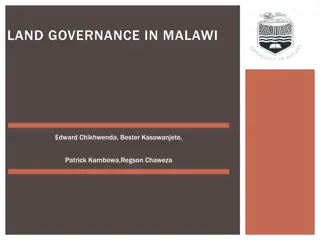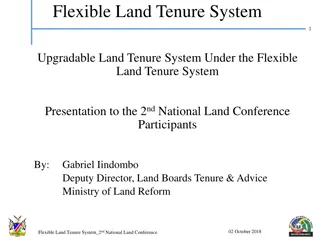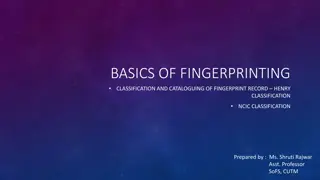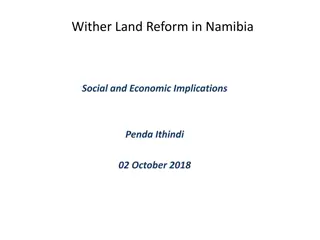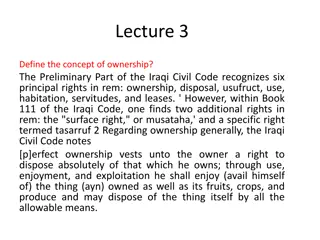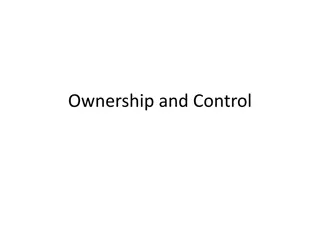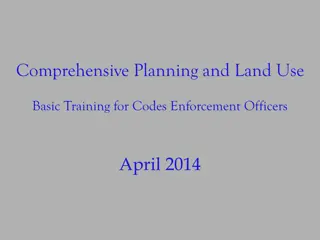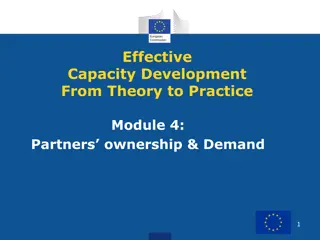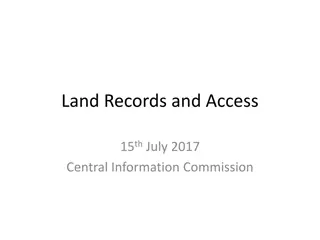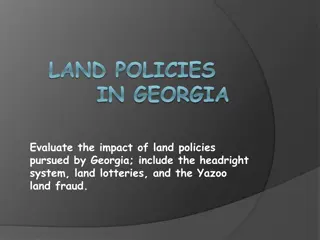Land Classification and Ownership
Land plays a crucial role in human society, serving as a resource base and a place for human activities. This resource is utilized for various purposes, and its management is vital for meeting human needs. The classification of land into biological, economic, physical, and spatial entities influences its utilization patterns. Factors such as natural elements, socio-economic conditions, and technological advancements determine land use practices, which evolve over time to cater to different human requirements.
Download Presentation

Please find below an Image/Link to download the presentation.
The content on the website is provided AS IS for your information and personal use only. It may not be sold, licensed, or shared on other websites without obtaining consent from the author.If you encounter any issues during the download, it is possible that the publisher has removed the file from their server.
You are allowed to download the files provided on this website for personal or commercial use, subject to the condition that they are used lawfully. All files are the property of their respective owners.
The content on the website is provided AS IS for your information and personal use only. It may not be sold, licensed, or shared on other websites without obtaining consent from the author.
E N D
Presentation Transcript
UNIT-I: Classification of lands Ownership of Land........ 4/16/2020 Ashwini Dalal 1
Dear Students Hi there Hear are the detailed notes on Unit 1, earlier provided you audio lectures on classification of land and ownership if you have any doubts of the concepts let me know by your feed back ..actually we have already discussed these topics in the class also . So be safe take care of your near and dear one and keep studying . 4/16/2020 Ashwini Dalal 2
LAND AND MAN Land is not only a resource, but also a resource base by itself. It is the place over which man lives and interacts. Man is basically a terrestrial animal. For many centuries man has been utilizing this resource extensively and became the master of the earth The socio-cultural and technological growth of human societies leave deep imprints more on land than any other resource base.
LAND AS A BIOLOGICAL ENTITY LAND AS AN ECONOMIC ENTITY LAND AS A PHYSICAL ENTITY LAND AS A SPATIAL(Local) ENTITY There are varied combinations of physical, socio-cultural and economic parameters. Hence land possesses permutation combinations arrangement over the space is a matter of great importance for the advancement and sustenance of human society innumerable and their
CONCEPT OF LAND USE Land use is the surface utilization of all developed and vacant land on a specific point, at a given time and space. According to the Food and Agriculture Organization of the United Nations (FAO), land use defines the human activities which are directly related to land, making use of its resources, or having an impact on them. In that context the emphasis is on the function or purpose for which the land is used and particular reference is made to the management of land to meet human needs
FACTORS OF LAND USE The land use pattern of a region is an outcome of natural and socio economic factors which decide the utilization of land by man over time and space. It is basically a function of four variables land, water, air and man. Each plays its own role in composing its life history. The efficient use of land depends on the capacity of man to utilize the land and to manage it. Land use may vary in nature and in intensity according to the purpose it serves whether it is food production, recreation, or mining and the biophysical characteristics of the land itself. The use of land has intensified with the increase of population, method and technology.
LAND USE CLASSIFICATION SCHEMES IN INDIA Land utilization statistics provide the area figures showing the distribution of the total geographical area of the country into its various uses. Detailed statistics of land utilization which mainly give area of land put to different uses are almost continuously available since 1884. In the year, the returns of Agricultural Statistics of British India , gave details of area cultivated and uncultivated, crops cultivated and irrigated. Separate statistics of land cropped and under current fallows, land available for cultivation and of area under forests were also collected. The geographical coverage of land use statistics has continuously increased up to 1884-85 to 1922-23, but there has been no substantial change during the subsequent years, until after the World War II. Due to the continuous increase in the coverage as also changes in the territory comprising India on account of separation of Burma, the partition and subsequent reorganizations of the State from time to time, comparable figures of land utilization are not available over a long period of time
The Indian Council of Agricultural Research ICAR NINE FOLD CLASSIFICATION (1951) use statistics are available for roughly 306 million hectares, constituting 93 percent of the total. Before 1950-51, in India, the land utilization statistics were available under five categories. They were: Forest Area not available for cultivation Other uncultivated land excluding current fallows Fallow land and Net area sown. This fivefold classification was merely a broad outline of land use in the country. It was found to be insufficient to meet the needs of agricultural planning. The States were also finding it difficult to present comparable data according to this classification owing to the lack of uniformity in the definitions and scope of classification covered by these five broad categories. Out of the total geographical area of 328 million hectares, the land- (i) (ii) (iii) (iv) (v)
To remove the non comparability and to break up the broad categories into smaller constituents for better comprehension, the Technical Committee on Co-ordination of Agricultural Statistics was set up in 1948 by the Ministry of Food and Agriculture. They classified the land use into the two basic types agricultural and non agricultural land uses. Non Agricultural Agricultural includes Permanent pastures and other grazing lands, Land under miscellaneous tree crops, Cultivable Fallow other than Current fallow, Current fallow and Net area sown. Agricultural land use are classified as Forest, Land put agricultural Barren and uncultivable land. Non agricultural uses to uses non- and waste, Thus the committee recommended a Ninefold land use classification and also put forward standard concepts and definitions for each land use class to be followed by all States in the country. This nine fold classification was widely used in all scientific studies in the last century
definition of land as define in the LA Act,1894 and MLRC,1966 Section 3(a)of the land AquisationAct,1894- the expression "land" includes benefits to arise out ofland, and things attached to the earth or permanently fastened to anything attached to the earth. The definition of land includes fishery rights and things attached to the earth. Even under the Transfer of Property Act. the expression 'land' includes building, standing trees and crops. Further as per the Maharashtra land Revenue code section 2 (16) "land" includes benefits to arise out of land, and things attached to the earth, or permanently fastened to anything attached to the earth, and also shares in or charges on, the revenue or rent of villages, or other defined portions of territory; Before classify the nine fold land, lets discuss the
Nine-fold classification of Land Use GOI Technical committee created a 9 fold classification of land and it was adopted by all states . Out of a geographical area of 329 million hectares (reporting area) statistics are available only from 305 million hectares (non-reporting area), which makes some areas to the extent of 7% still not covered or classifiable under the nine-fold classification. For the purpose of assessment all land shall be classed with respect to its productive qualities. The number of classes and their relative value is done in the rupee scale, and reckoned in terms of soil units in the areas, shall be fixed under the orders of the Director with reference to the circumstances of the different tracts of the country to which the survey extends and to the nature of the cultivation. The reporting area is classified into the following nine categories: 1.Forests: enactment dealing with forests or administered as forests, whether state-owned or private, and whether wooded or maintained as potential forest land. The area of crops raised in the forest and grazing lands or areas open for grazing within the forests should remain included under the forest area. This includes all lands classed as forest under any legal
2.Area under Non-agricultural Uses: This includes all lands occupied by buildings, roads and railways or under water, e.g. rivers and canals and other lands put to uses other than agriculture. 3.Barren and Unculturable Land: includes all barren and un-culturable land like mountains, deserts, etc. Land which cannot be brought under cultivation except at an exorbitant cost, should be classed as un-culturable whether such land is in isolated blocks or within cultivated holdings. 4.Permanent Pastures and other Grazing Lands: includes all grazing lands whether they are permanent pastures and meadows or not. Village common grazing land is included under this head.
5.Land under Miscellaneous Tree Crops, etc. : This includes all cultivable land which is not included in Net area sown but is put to some agricultural uses. Lands under Casurina trees, thatching grasses, bamboo bushes and other groves for fuel, etc. which are not included under Orchards should be classed under this category. 6.Culturable Waste Land: This includes lands available for cultivation, whether not taken up for cultivation or taken up for cultivation once but not cultivated during the current year and the last five years or more in succession for one reason or other. Such lands may be either fallow or covered with shrubs and jungles, which are not put to any use. They may be assessed or unassessed and may lie in isolated blocks or within cultivated holdings. Land once cultivated but not cultivated for five years in succession should also be included in this category at the end of the five years. 7.Fallow Lands other than Current Fallows: This includes all lands, which were taken up for cultivation but are temporarily out of cultivation for a period of not less than one year and not more than five years. 8.Current Fallows: This represents cropped area, which are kept fallow during the current year. For example, if any seeding area is not cropped against the same year it may be treated as current fallow. 9.Net area Sown: This represents the total area sown with crops and orchards. Area sown more than once in the same year is counted only once.
Ownership of Land Absolute and limited ownership (tenancy, lease etc.) 4/16/2020 Ashwini Dalal 14
Right to property. since (1950 -1978) between the parliament and the judiciary. During this conflict, judges were accused of class bias because they struck down legislation intended to expropriate land from landlords with large holdings, paying little or no compensation, and to redistribute the land to tillers whilst protecting the tenants The conflict between the two branches of government could not be on account of different ideologies. Prime Minister Nehru believed that landlords who had exploited their tenants, had extravagantly pompous life-styles and were also agents ( an intermediary) of the British Raj, deserved to have less protection for their property, whereas the tenants or tillers to whom the state redistributed the land ought to have their property protected in greater measure. The tendency to shift blame and responsibility for the failure of land policy reached its high point in 1975 when a state of internal emergency was imposed by Prime Minister Indira Gandhi. The suspension of fundamental rights was defended by the government with the claim, among others, that judicial review of agrarian legislation obstructed redistribution of surplus land and other egalitarian measures. In India the right to property has been the cause of a long period of conflict 4/16/2020 Ashwini Dalal 15
to suspend fundamental rights and impose emergency rule, as was done on grounds of internal disturbance in 1975. But this Amendment also removed the right to property from the list of fundamental rights. Property is now recognized as a legal right in Article 300A of the constitution: No person shall be deprived of his property save by authority of law. Farmers whose land is generally acquired by the government for public purposes have little knowledge about their constitutional and legal rights. Recognizing that such injustices have become rampant, Indias parliament, passed the Right to Fair Compensation and Transparency in Land Acquisition, Rehabilitation, and Resettlement Act (LAAR), 2013. This Act intends to safeguard the interests of indigenous people (tribals) and stipulates norms for fair compensation, resettlement and rehabilitation of persons displaced on account of land acquisition. It has new provisions for social impact analysis and recognition of non-owners as affected persons, and it prescribes some norms of free, prior informed consent of people affected by land acquisition. From the point of view of inclusiveness, a dozen laws that affect vulnerable and marginalized people continue to be in force. Nearly 90 percent of the central governments land acquisition in mineral-rich region has been carried out under these other laws, and it may be the case that the new and more progressive land acquisition legislation will not be used very extensively. The Constitutions Forty-Fourth Amendment was intended to make it difficult 4/16/2020 Ashwini Dalal 16
Ownership of land depends on its location; and with growing population its demand keeps increasing, while its supply is limited. Access to land (or land rights) has a wide-ranging impact on livelihoods, and industrial, economic, and social growth. People with land rights are found to be better off than the landless, due to better access to markets and other economic opportunities that come with such rights. Land ownership is broadly determined by access to a land title, a document that states such ownership. Having a clear land title protects the rights of the title-holder against other claims made by anyone else to the property. In India, land ownership is determined through various records such as registered sale deeds, property tax documents, and government survey records Land is a unique asset because it is immovable; its value 4/16/2020 Ashwini Dalal 17
The concept of ownership is one of the fundamental juristic concepts common to all systems of law. The idea of possession came first in the minds of people and it was later on that the idea of ownership came into existence. Ownership is a complex juristic concept which has its origin in the Ancient Roman Law. In Roman law ownership and possession were respectively termed as dominium and possessio . The term dominium denotes absolute right to a thing while possessio implied only physical control over it. They gave more importance to ownership . In English law the concept of ownership developed much later than possession. The earlier law gave importance to possession on the misconception that possession includes within it ownership as well. Holdsworth observed that the English law accepted the concept of ownership as an absolute right through the gradual development in the law of possession. The concept of ownership consists of a number of claims such as liberty, power and immunity in regard to the thing owned. Ownership is thus a sum-total of possession, disposition and destruction which includes the right to enjoy property by the owner. The owner has to side by side abide by the rules and regulation of the country. 4/16/2020 Ashwini Dalal 18
DEFINITION OF OWNERSHIP Jurists have defined ownership in different ways. All of them accept the right of ownership as the complete or supreme right that can be exercised over anything. Thus, according to Hibbert ownership includes four kinds of rights within itself. 1. Right to use a thing 2. Right to exclude others from using the thing 3. Disposing of the thing 4. Right to destroy it. 4/16/2020 Ashwini Dalal 19
Austins definition Austin while defining ownership has focused on the three main attributes of ownership, namely, indefinite user, unrestricted disposition and unlimited duration which may be analysed in detail 1. Indefinite User: By the right of indefinite user Austin means that the owner of the thing is free to use or misuse the thing in a way he likes. The pawner of a land may use it for walking, for building house or for gardening and so forth. However Austin was cautious enough to use the term indefinite . He did not use the thing owned infamy way he likes. His use if the thing is conditioned by requirements or restrictions imposed by the law. The owned must not use the things owned as to injure the right of others. The principle is the foundation of the well known maxim sie utere tero ut alierum non laedas the meaning of the maxims is that to use your own propertys not to injure your neighbour s right. Again the use of property may be restricted voluntarily e.g. town planning act, slum clearance act, 1955 etc. 4/16/2020 Ashwini Dalal 20
2. Unrestricted Disposition: What Austin implies by unrestricted disposition is that the power of disposition of the pawner is unhampered by law meaning thereby that he is absolutely free to dispose it to remove it to anyone This is incorrect. In case of lease of thousand years, servitudes and restricted, covenants, plenary control of a property is not possible. Moreover, in the law of the some of the western countries there is rule re relegitima portis which means that the person cannot dispose of his entire property. He has to keep a certain portion of the property for the members of his family. Under mohamdan law a similar rule prevails namely a person cannot dispose and delaying creditors would be set aside. As under Hindu law government by mitakashara law can t alienate ancestral immovable property without the consent of other coperceners except for legal necessity. 3. Unlimited Duration: It is incorrect since almost under every legal system the state possesses the power to take over the property of any person in public interest. The abolition of Zamindari system India , the abolition of privy purses, nationalization of Bank etc. are some example of the fact that the ownership can be cut short by the state for public purpose and its duration is not unlimited. Austin s definition has been followed by Holland. He defines ownership as plenary control over an object. According to him an owner has three rights on the subject owned: .1. Possession 2.Enjoyment 3.Disposition Plenary control over an object implies complete control unrestricted by any law or fact. Thus, the criticism levelled against Austin s definition would apply to that given by Holland in so far as the implication of the term plenarycontrol goes. 4/16/2020 Ashwini Dalal 21
Salmonds Definition: exclusive of all others. For Salmond what constitute ownership is a bundle of rights which in here resides in an individual. Salmond s definition thus point out two attributes of ownership: 1.Ownership is a relation between a person and right that is vested in him 2.Ownership is incorporeal body or form According to the Salmond - ownership vests in the complex of rights which he exercises to the MODERN LAW AND OWNERSHIPUnder modern law there are the following modes of acquiring ownership which may be broadly classed under two heads, viz,. 1. Original mode: 2. Derivative mode: 1.Original mode:The original mode is the result of some independence personal act of the acquire himself. The mode of acquisition may be three kinds a) Absolute: when a ownership is acquired by over previously ownerless object. b) Extinctive: which is where there is extinctive of previous ownership by an independence adverse act on the part of the acquiring. This is how a right of easement is acquiring after passage of time prescribed by law. c) Accessory: that is when requisition of ownership is the result of accession. For example, if three fruits, the produce belongs to the owner unless he has parted with to the same. 2.Derivative mode: When ownership is derived from the previous version of law then it is called derivate acquisition. That is derived mode takes place from the title of prior owner. It is derived either by purchase, exchange, will, gift etc. 4/16/2020 Ashwini Dalal 22
Kinds of Ownership There are many kinds of ownership and some of them are I. Corporeal and incorporeal ownership; 2. Sole ownership and co-ownership; 3. Legal and equitable ownership; 4. Trust and beneficial ownership; . 5. Vested and contingent ownership; and . 6. Absolute and limited ownership; 4/16/2020 Ashwini Dalal 23
Absolute and Limited Ownership limited by agreements or by operation of law. When in a person all the rights of ownership (i.e. Possession, enjoyment and disposal) vested without any restriction (except that imposed by law in the interest of society), his ownership is absolute ownership. But when there are limitations on user, or duration or diposal, the ownership is limited ownership. e.g.of limited ownership in English law is life tenancy when an estate is held only for life. In Hindu law (before 1956), women s estate was a limited ownership. If a hindu women inherited property from a male or female, it was called women s estate. She held the property only for her life and had only a limited power of disposal. After her death, the property went to the heirs of the last holder of the property. That is, it may be exclusive or limited. Ownership can be 4/16/2020 Ashwini Dalal 24
Tenancy, lease etc. Tenancy refers to the possession or occupancy of lands, buildings or other property by title through a lease or on payment of rent. In other words is the right to use property for specified amount of time, as granted by the owner. Tenancy right means that you do not need to own the property in order to use and benefit from it CONCEPT OF A LEASE 1. Definition of Lease: Lease of an immovable property is defined and detailed under Chapter V of the Transfer of Property Act, 1882. Section 105 of the Act defines the term lease , lessor , lessee , premium and rent . Section 105 of the Act - a lease of immovable property is a transfer of a right to enjoy such property, made for a certain time, express or implied, or in perpetuity, in consideration of a price paid or promised, or of money, a share of crops, service or any other thing of value, to be rendered periodically or on specified occasions to the transferor by the transferee, who accepts the transfer on such terms. Lessor, lessee, premium and rent defined: The transferor is called the lessor, the transferee is called the lessee, the price is called the premium, and the money, share, service or other thing to be so rendered is called the rent. 2. Essential Ingrediants of a Lease: (a) Transfer of right in the property An interest in the subject property is to be created in favour of the lessee by the lessor . (b) Duration of a lease Interest created in the property could be for a specified period (either expressedor implied) or even in perpetuity. Parties to the lease are at liberty to decide the duration of the said lease. (c) Consideration A valid consideration needs to be paid, periodically or on specified occassions by the lessee to the lessor. 4/16/2020 Ashwini Dalal 25
3. Term of a Lease: Section 107 of the Act provides that a lease of an immovable property for a term exceeding a year can only be made by a registered instrument . In the event, the same is not made through a registered instrument, then, contrary to what is mentioned in the said lease, the duration of the lease will be assumed to be of a month, and the same may be terminated by either party by providing a fifteen days notice . However, in case the term is less that a year, then the said lease may be made either by oral agreement accompanied possession of the immovable property, or by a registered instrument. by delivery of 4/16/2020 Ashwini Dalal 26
4. Determination of a Lease: Section 111 of the Act details the events/ means by which a lease may be determined. A lease of immovable property determines- (a) by efflux of the time limited thereby, (b) where such time is limited conditionally on the happening of some event-by the happening of such event, (c) where the interest of the lessor in the property terminates on, or his power to dispose of the same extends only to, the happening of any event-by the happening of such event, (d) in case the interests of the lessee and the lessor in the whole of the property become vested at the same time in one person in the same right, (e) by express surrender, that is to say, in case the lessee yields up his interest under the lease to the lessor, by mutual agreement between them, (f) by implied surrender, 4/16/2020 Ashwini Dalal 27
(g) by forfeiture; that is to say, (1) in case the lessee breaks an express condition which provides that, on breach thereof, the lessor may re-enter; or (2) in case the lessee renounces his character as such by setting up a title in a third person or by claiming title in himself; or (3) the lessee is adjudicated an insolvent and the lease provides that the lessor may re-enter on the happening of such event; and in any of these cases the lessor or his transferee gives notice in writing to the lessee of his intention to determine the lease, (h) on the expiration of a notice to determine the lease, or to quit, or of intention to quit, the property leased, duly given by one party to the other. Thus, it may be clearly understood that a lease may be determined on occurance of any of the events as mentioned under Section 111 of the Act. 5. Effects of Determination of a Lease By Efflux of Time: Upon determination of a lease by efflux of time, all rights, title and interest of the lessee under the lease, cease to exist, and the lessee is bound to put the lessor into possession of the property. If the lessee continues to remain in possession of the property, without the consent of the lessor, such possession becomes wrongful from the date of the termination of the lease, and the lessee is a mere trespasser and has no right to remain in the property, and the lessorhas a right to enter upon the property immediately after the expiration of the term without any further notice. 4/16/2020 Ashwini Dalal 28
Doctrine of Eminent Domain Doctrine of Escheat - Doctrine of Bona Vacantia 4/16/2020 Ashwini Dalal 29
Eminent Domain rooted in the idea of eminent domain. The doctrine of eminent domain states, the sovereign can do anything, if the act of sovereign involves public interest. The doctrine empowers the sovereign to acquire private land for a public use, provided the public nature of the usage can be demonstrated beyond doubt. The doctrine is based on the following two Latin maxims, (1) Salus populi suprema lex (Welfare of the People Is the Paramount Law) and (2) (2) Necessitas publica major est quam (Public Necessity Is Greater Than Private Necessity). In the history of modern India, this doctrine was challenged twice (broadly speaking) once when land reform was initiated and another time when Banks were nationalized. The power to take property from the individual is 4/16/2020 Ashwini Dalal 30
property (which includes land) under Articles 19 and 31. Article 19 guaranteed that all citizens have the right to acquire, hold and dispose of property. Article 31 stated that "no person shall be deprived of his property save by authority of law." It also indicated that compensation would be paid to a person whose property has been taken for public purposes . The Forty-Fourth Amendment of 1978 deleted the right to property from the list of fundamental rights with an introduction of a new provision, Article 300-A, which provided that "no person shall be deprived of his property save by authority of law" (Constitution 44th Amendment, w.e.f. 10.6.1979). The amendment ensured that the right to property is no longer a fundamental right but rather a constitutional/legal right/as a statutory right and in the event of breach, the remedy available to an aggrieved person is through the High Court under Article 226 of the Indian Constitution and not the Supreme Court under Article 32 of the Constitution. The Constitution of India originally provided the right to 4/16/2020 Ashwini Dalal 31
structure acquired (Inserted by Constitution, Seventeenth Amendment) Act, 1964, the same can be found in the earlier rulings when property right was a fundamental right (such as 1954 AIR 170, 1954 SCR 558, which propounded that the word "Compensation" deployed in Article 31(2) implied full compensation, that is the market value of the property at the time of the acquisition. The Legislature must "ensure that what is determined as payable must be compensation, that is, a just equivalent of what the owner has been deprived of". Justice, Reddy, O Chinnappa ruled (State Of Maharashtra v. Chandrabhan Tale ) that the fundamental right to property has been abolished because of its incompatibility with the goals of "justice" social, economic and political and "equality of status and of opportunity" and with the establishment of "a socialist democratic republic, as contemplated by the Constitution. There is no reason why a new concept of property should be introduced in the place of the old so as to bring in its wake the vestiges of the doctrine of Laissez Faire and create, in the name of efficiency, a new oligarchy. Efficiency has many facets and one is yet to discover an infallible test of efficiency to suit the widely differing needs of a developing society such as ours" (1983 AIR 803, 1983 SCR (3) 327). The concept of efficiency has been introduced by Justice Reddy, O Chinnappa, very interestingly coupled with the condition of infallibility State must pay compensation at the market value for such land, building or 4/16/2020 Ashwini Dalal 32
the property rights, a new phase had begun. K. K. Mathew, justice of Kesavananda Bharati vs. State of Kerala stated this precisely: "Property in consumable goods or means of production worked by their owners were justified as necessary condition of a free and purposeful life; but when property gave power not only over things but through things over persons also, it was not justified as it was an instrument of servitude rather than freedom Eminent domain doctrine has been widely used in India since the era of Independence, with over 21.6 million people in the period of 1951-90. They have been displaced with large-scale projects like dams, canals, thermal plants, sanctuaries, industrial facilities, and mining These occurrences are "development-induced displacement". In India, with this introduction of social elements to generally categorized as 4/16/2020 Ashwini Dalal 33
against the acquisition of land by various industrialists. They have ranged from Bengal, Karnataka, and Uttar Pradesh in the recent past. The acquisition of 997 acres of land by Tata motors in Bengal in order to set up a factory for the cheapest car in India was protested (Singur Tata Nano controversy).At least a decade before the Singur episode similar events occurred in West Bengal, although the opposition parties and other civil society organisations remained silent at that time. Similarly, the SardarSarova Dam project on the river Narmada was planned on acquired land, though the project was later canceled by the World Bank The Land Acquisition Act of 1894 allowed the government to acquire private lands. It is the only legislation pertaining to land acquisition which, though amended several times, has failed to serve its purpose. Under the 1894 Act, displaced people were only liable for monetary compensation linked with market value of the land in question, which was still quite minimal considering circle rates are often misleading There have been a rising number of political and social protests 4/16/2020 Ashwini Dalal 34
Doctrine of Escheat or bona vacantia in India The Doctrine of bona vacantia or Escheat was declared to be a part of the law in India by the Privy Council as early as in 1860 in Collector of Masulipatam v. Cavary Vancata Narrainappah, (1859-61) This case also held that the General Law of universal application and that General Law was that private ownership not existing, the State must be the owner as the ultimate Lord . Article 296 of the Constitution of India provides that any property in the territory of India which would have accrued to the ruler of an independent State by escheat or lapse or as bona vacantia for want of a rightful owner shall if it is the property situate in a State, vest in such State, and in any other case in the Union of India. 4/16/2020 Ashwini Dalal 35
Definition of escheat Black s Law Dictionary defines escheat as: 1. The reversion of land ownership back to the lord when the immediate tenant dies without heirs. 2. Reversion of property (especially real property) to the state upon the death of an owner who has neither a will nor any legal heirs. 3. Property that has so reverted. Thus we see that Doctrine of Escheat is a common law doctrine which transfers the property of a person who dies without heirs to the crown or the state. It serves to ensure that property is not left in limbo without recognized ownership. 4/16/2020 Ashwini Dalal 36
law. The maxim Bona vacantia is used for the situation in which property is left without any clear owner. The owner of the goods or property is not known. If no ownership is claimed over those goods or property then the goods or the property goes to the government and the government serves as the custodian of those goods or property. The government has to take such goods and act as their owners for perpetuity. The cases of such ownership arises when the goods or the property are being abandoned when the person dies without any living heirs. Such situation can also arise when a business or unincorporated association is dissolved the assets thereof are not distributed appropriately. Other process how such situation arises are when a trust in the path of failing or when the property owner in nowhere to be found and does not any information about its whereabouts. In other words it is a property without any claim. Bona vacantia is used for those goods and property which does not have any ownership. Ownership and property are two interrelated concepts. There cannot be any ownership without any property and also there can be any property without ownership. The concept of bona vacantia has its origins from the common 4/16/2020 Ashwini Dalal 37
In the case of Sita Ram Jaiswal and others v State of U.P. and others (2016 (118) ALR 146)it was observed by the court that the right of the King to take property by escheat or as bona vacantia was recognized by common law of England. Escheat property was the lord s right of re-entry on real property held by a tenant dying intestate without lawful heirs. It was an incident of feudal tenure and based on the want of a tenant to perform the feudal services. On the tenant dying intestate without leaving any lawful heirs, his estate came to an end and the lord was in by his own right and not by way of succession or inheritance from the tenant to re- enter the real property as owner. In most of the cases the land escheated to the Crown as the lord paramount, in view of the gradual elimination of intermediate or mesne lords since 1290 AD. The Crown takes as bona vacantia goods in which no one else can claim property. it is the right of the Crown to bona vacantia to property which has no other owner. The right of the Crown to take as bona vacantia extends to personal property of every kind. Giving a notice at this stage that the escheat of real property of an intestate dying without heirs was abolished in 1925 and the Crown cannot take its property as bona vacantia. 4/16/2020 Ashwini Dalal 38
Shankerlal(AIR 1980 SC 575) observed that if the company had a subsisting interest in the lease on the date of dissolution such interest must necessarily vest in the Government by escheat or as bona vacantia. In India the law is well settled that the property of an intestate dying without leaving lawful heirs and the property of a dissolved Corporation passes to the Government by escheat or as bona vacantia. In the case of State of Gujarat and Another v Shri Ambica Mills Limited Ahmedabad and Another(AIR 1974 SC 1300) it was observed it is only if no claim is made for a period of 4 years from the date of the publication of the first notice, or, if a claim is made but rejected wholly or in part, that the State appropriates the unpaid accumulations as bona vacantia. It is not as if unpaid accumulations become bona vacantia on the expiration of three years. They are, no doubt, deemed to be abandoned property under section 6(A)1, but they are not appropriated as bona vacantia until after claims are invited in pursuance to public notice and disposed of. At common law, abandoned personal property could not be the subject of escheat. It could only be appropriated by the sovereign as bona vacantia The Sovereign has a prerogative right to appropriate bona vacantia. And abandoned property can be appropriated by the Sovereign as bona vacantia. The Supreme Court in the case of Narendra Bahadur Tandon v 4/16/2020 Ashwini Dalal 39
Maintenance of land records and issue of Pattas a 4/16/2020 Ashwini Dalal 40
elaborated in Section 2(18) of MLRC,1966 Accordingly, "land records" means records maintained under the provisions of or for the purposes of, this Code and includes a copy of maps and plans of a final town planning scheme, improvement scheme or a scheme of consolidation of holdings which has come into force in any area under any law in force in the State and forwarded to any revenue or survey officer under such law or otherwise. The Definition of Land Record has been 4/16/2020 Ashwini Dalal 41
The evolution of land records Prior to independence, land was mostly concentrated with the landlords or zamindars, who had permanent property rights. The zamindars collected land rent from a given territory, and paid a fixed sum as land revenue to the government. This land revenue formed a key source of government income. However, the rent that was to be paid by the cultivator tenants was unregulated, and was subject to the discretion of the landlords. This allowed the landlords to make profits by charging rents in excess of the amount to be paid as revenue. Since the landlords were primarily interested in maximising rent collection, a system of land records was created and maintained to facilitate this process. These land records furnished information important for land revenue assessment such as, area of the property, and details of the person in possession of the property. Post- independence, the zamindari system was abolished, but land ownership continued to be determined through a combination of these records. 4/16/2020 Ashwini Dalal 42
transferred to states. All the records were collected and maintained manually by the respective revenue department. Further, with the abolition of the zamindari system, a few land reforms were implemented. These included policies on redistribution of land, and tenancy reforms. The land redistribution reforms sought to put a cap on the amount of land a person could hold, and consolidation of such extra land with the government. These were known as land ceiling laws, which were later repealed in urban areas (mostly because they were not successful, and resulted in unused land banks with the government). The tenancy reforms broadly aimed at: conferring security of tenure on tenant cultivators (to provide them some form of land rights), and fixing fair rents for tenants. However, these were also mostly unsuccessful. Currently, most states have either legally banned or imposed restrictions on agricultural land leasing, which has led to informal tenancy across the country. Post-independence, the responsibility for land administration was (i) (ii) 4/16/2020 Ashwini Dalal 43
LAND AS A VALUABLE ASSET Land ownership is broadly defined by the access to a land title. Land title is a document that determines the ownership of land or an immovable property. Having a clear land title protects the rights of the title holder against other claims made by anyone else to the property. In India, land ownership is determined through various records such as sale deeds that are registered, property tax documents, government survey records, etc. However, land titles in India are unclear due to various reasons such as legacy issues of the zamindari system, gaps in the legal framework, and poor administration of land records. This has led to several legal disputes related to land ownership, and affected the agriculture and real estate sectors. Such issues have further highlighted the importance of having clear land titles, and a well organised land records system. 4/16/2020 Ashwini Dalal 44
Legal framework independence days i.e. zamindari system, and has not changed much since then. These land records provided, in addition to other details, information on who is in possession of land, and not who the owner is. This has resulted in a system, where ownership is established based on who is in current possession of the land. Such possession is determined through a sequence of past transactions of the land or property in question. The transfer of land or property between a buyer and seller is recorded through a sale deed, which needs to be registered according to the current legal framework. Therefore, such registration of land refers to the registration of the transaction, and not the land title. Such registration does not guarantee the title by the government. This implies that even bonafide property transactions may not always guarantee ownership as an earlier transfer of the title could be challenged. Currently, land can be transferred from one party to another through sale, purchase, gift, inheritance, mortgage, and tenancy. The Transfer of Property Act, 1882 provides that the right, title, or interest in an immovable property (or land) can be transferred only by a registered instrument. The Registration Act, 1908, is the primary law that regulates documents. Therefore, currently, all sale deeds relating to land or immovable property transfer are registered under the Registration Act, 1908. The current system of land records was inherited from the pre- the registration of land related 4/16/2020 Ashwini Dalal 45
identity of the buyer and the seller needs to be checked, and whether the last sale deed was registered. While the identity of the buyer and the seller is verified through various identity proof documents, the physical location and attributes of the land being sold may not always be cross-checked physically by the registrar (district official responsible for registration). Further, only checking the identity of the sellers may not necessarily mean that they are the rightful owners of such land or property. Registration of a sale deed makes the document of transfer a permanent public record. From these records, any person interested in purchasing that property can verify in whose name the deed was last registered. If a deed of land transfer for which registration is compulsory under the Registration Act, 1908 is not registered, then it is not admissible as evidence of ownership in courts. The onus of checking the validity of the title (or rightful ownership of the property) is on the buyer, and not on the government. Such verification requires delving into past ownerships and transactions to establish non-encumbrance. It is difficult to carry out this process if past transactions are not recorded properly and there are gaps between the records with the government and the actual state of land ownership. Gaps or mistakes in old land records also make it easier to question the ownership. As per the Registration Act, 1908, when registering a property sale deed, the 4/16/2020 Ashwini Dalal 46
in 2009 had recommended moving from a presumptive to a conclusive titling system. state guaranteed titles, where the state guarantees the title for its correctness and provides for compensation in case of any disputes. The central government s scheme on modernisation of land records (Digital India Land Records Modernisation Programme, (or DILRMP) also seeks to create a system that will help move towards conclusive titling. recommended providing reasonable rules to allocate the liability for any loss or damage caused by an error in the administration of the registration and record search system. The Committee on Financial Sector Reforms (FSRC) Conclusive titles are The FSRC had also 4/16/2020 Ashwini Dalal 47
Maintenance of land records Land administration essentially involves recording, processing and dissemination of information about the ownership, value, and use of land. The system of land records management varies across states, depending on factors such as historical evolution and local traditions. Broadly, such information can be classified as details of the property (such as tax documents, rental documents), spatial records (such as maps, boundary limits), and transaction records (registered sale deeds). Today, land ownership can be determined through a set of documents. These include: (i) the record of rights (RoR), which captures details such as the name of the land holder, the number and size of the plot area, and revenue rate (for agricultural land), (ii) the registered sale deed to prove that the property has been sold from one person to the other, and the taxes on the sale have been paid, (iii) survey documents to record a property s boundaries and area, and prove that the property is listed in government records, and (iv) property tax receipts. 4/16/2020 Ashwini Dalal 48
Land Records Land records are a combination of three types of data records: (i) textual (RoR), (ii) spatial (maps), and (iii) transaction details (sale deeds). Three different state departments are responsible for each of this data on land records. In the presence of multiple agencies responsible for registration and maintenance of records, it is difficult to ensure that survey maps, textual data, and registration records match with each other and are updated. In addition, citizens have to approach several agencies to get complete information on land records Typically, across states, these land records are stored and managed in the following manner: Sale deed: At the time of purchase of an immovable property (land or property), both the seller and buyer sign a sale deed (a non-judicial stamp paper of a prescribed amount). Typically, a sale deed contains details of the property, market price of the property, and details of past transactions on the property. The sale deed is registered under the Registration Act, 1908. It is registered on a stamp paper, and the value of the stamp paper is known as stamp duty. Once the deed is registered, details about the transaction are sent to the tehsil/taluka office to start the process of mutation (recording the transfer or change of title of a property in the land records) and reflect this change in the record of rights. Once the mutation/transfer comes into effect, the state government (through the tehsil/taluka office) provides documentary evidence of right over land in the form of a patta. This patta is then provided to the buyer as an evidence of land right. 4/16/2020 Ashwini Dalal 49
whose name it is registered is the owner of the land. The revenue record is maintained at the office of the concerned Tahsildar, and is issued by the Registrar of land holdings. A patta signifies the lawful possession of the land, and is therefore an essential document required property transactions. Patta establishes the lawful ownership and possession of a property. In case of disputes between the government and a land holder, or a third party and a land holder, the patta acts as a safeguard for the interests of the legal owners in whose name it is issued. Further, in case the government acquires the land, the patta holder receive a compensation as he or she holds the first right over that property. Patta also bears important details regarding the extent of the property and its measurements. Land patta is a legal document that states that the person in 4/16/2020 Ashwini Dalal 50
